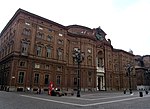Teatro Carignano

The Teatro Carignano (Carignano Theatre) is a theatre in Turin and one of the oldest and most important theatres in Italy. Designed by Benedetto Alfieri, it is located opposite the Palazzo Carignano. Building commenced in 1752 and the theatre was inaugurated the following year with a performance of Baldassare Galuppi's opera, Calamità de' cuori. Much of the theatre was destroyed in a fire in 1786, but it was rebuilt in a few months using Alfieri's original plans. Since then it has undergone several renovations. Although today it is primarily used for performances of plays, in the past it was an important opera house. The theatre is owned by the City of Turin but administered by the theatre company, Teatro Stabile di Torino, and is one of the company's principal performing venues.
Excerpt from the Wikipedia article Teatro Carignano (License: CC BY-SA 3.0, Authors, Images).Teatro Carignano
Turin Circoscrizione 1
Geographical coordinates (GPS) Address External links Nearby Places Show on map
Geographical coordinates (GPS)
| Latitude | Longitude |
|---|---|
| N 45.0693 ° | E 7.6846 ° |
Address
Teatro Carignano
6
10123 Turin, Circoscrizione 1
Piedmont, Italy
Open on Google Maps











